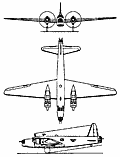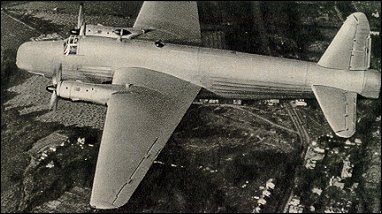|
| The Wellington, which served Bomber Command so well in the early years of World War II, is remembered by the RAF and the people of Britain as the 'Wimpey' - a nickname derived from an American cartoon character possessing the proud name J. Wellington Wimpey. It was designed to meet an Air Ministry requirement for a long-range medium bomber under Specification B.9/32 and evolved as a mid-wing monoplane with a fuselage of oval cross-section. Both of these major structures were of the geodetic construction which Barnes Wallis had introduced in the Wellesley. But experience with the latter and development of the geodetic concept made it possible for the individual components (which were built up into the 'basket-weave' structure) to be smaller and
lighter in weight without any loss of structuial integrity by comparison with the Wellesley. Wings, fuselage and tail unit were fabric-covered; power plant comprised two wing-mounted engines; and the tailwheel-type landing-gear units were hydraulically retractable.
'Heavy' defensive armament - comprising five machine-guns in nose and tail turrets and a ventral dustbin - would, it was believed, enable a flight of these aircraft to put up such a curtain of fire that fighter escort would be superfluous. Those who held such beliefs (as for the Boeing B-17 Fortress developed in America) were to discover their error very quickly.
The prototype Wellington made its first flight on 15 June 1936, but it was not until October 1938 that production aircraft began to enter RAF service. Less than one year later (on 4 September 1939) Wellingtons were in action against targets in Germany. Early deployment on daylight raids showed that these and other British bomber aircraft were extremely vulnerable to fighter attack. Following the loss of ten Wellingtons from a force of 24 despatched on an armed reconnaissance of Wilhelmshaven on 18 December 1939, the type was withdrawn from daylight operations. As a night bomber, however, the Wellington proved an invaluable weapon during the early years of Bomber Command's offensive against Germany.
Wellington production was to total 11,461 aircraft and embraced many versions. These included Mk I bombers (782kW Bristol Pegasus XVIIIs) and the DWI with degaussing ring to trigger magnetic mines. Differing engines distinguished the 853kW Rolls-Royce Merlin X-powered Mk II; 1,021kW Bristol Hercules XI Mk III; and Pratt & Whitney Twin Wasp Mk IV. The Wellington Mk V was a high-altitude aircraft with pressurised cabin, no nose turret and increased wing span, followed by the high-altitude Mk VI with 1,192kW Rolls-Royce Merlin 60 or 62 R6SM engines. Mk VII was designated an experimental model and Mk VIII was the first of many reconnaissance versions. Mk IX aircraft were Mk Is modified as troop carriers. The Mk X with Hercules VI or XVI engines was the last bomber. Wellingtons Mk XI, XII and XIII were ASV radar-equipped aircraft for Coastal Command. The Mk XIV with Hercules XVII engines was the final reconnaissance version. In addition to these specific versions there were many variants, and Wellingtons were also used for training and transport.
 | A three-view drawing of Type 406 Wellington Mk. II (916 x 836) |
| MODEL | Wellington Mk X |
| CREW | 4 |
| ENGINE | 2 x Bristol Hercules XI, 1119kW |
| WEIGHTS |
| Take-off weight | 13381 kg | 29500 lb |
| Empty weight | 8417 kg | 18556 lb |
| DIMENSIONS |
| Wingspan | 26.26 m | 86 ft 2 in |
| Length | 18.54 m | 61 ft 10 in |
| Height | 5.31 m | 17 ft 5 in |
| Wing area | 70.0 m2 | 753.47 sq ft |
| PERFORMANCE |
| Max. speed | 410 km/h | 255 mph |
| Ceiling | 5790 m | 19000 ft |
| Range w/max payload | 2478 km | 1540 miles |
| ARMAMENT | 8 x 7.7mm machine-guns, 2041kg of bombs |
| Shorty, e-mail, 14.02.2011 23:18 Folks looking for specific aircraft The RAF Museum used to send out Aircraft Movement Cards - photocopies of the cards that followed each aircraft from test flights to squadron service and the final ending of its service - shot down. crashed and repaired and FTR (failed to return). Hopes this helps. reply | | Peter Robertson, e-mail, 12.02.2011 21:52 My father Squadron Leader James A Robertson flew the Wimpy also Lancasters and other bombers during WW11 .
Squadrons 7@Oakington, 156@ Upwood and 214 @ Feltwell reply | | richard empson, e-mail, 09.02.2011 12:05 can you suggest how i can obtain information about every individual wellingtons that were manufactured. many thanks reply | | jim bethell, e-mail, 30.12.2010 17:26 Does anyone have any details of German air raids carried out on RAF Broughton when it was producing the Wimpy? Any newspaper reports or details about dates appreciated. reply | |
| | Marion Thomas nee Marsh, e-mail, 25.12.2010 21:45 Just a little wimsy about the Wellington bomber.
When I was a little girl in Gloucester, England, during the second world war, a cousin was in the Airforce and brought a tiny tabby kitten to us one day which he had found on the tarmac underneath a Wellington bomber and he had named her 'WIMPY ' I never understood why until now!Thus started my love of animals. reply | | Fraser Campbell, e-mail, 02.12.2010 15:19 My uncle, John (Jack) William Downs was a pilot of Wellingtons duting WWII. He was in North Africa and died of malaria in Tunisia. reply | | Ian Forrest, e-mail, 21.11.2010 17:23 was nvigator 1947 in malta communicatios
n
was navigator 1947 of malta communications flight wimpey
onsicily -sardinia-libya routes carying 12 passengers.
stripped of turrets itcruised atabout 200 mph from luqa
airport>We were a single crew and one plane which was
scrapped just before I was demobbed.were there others?
flight
navigate
was navigato
rr reply | | Peter Hedgy, e-mail, 21.10.2010 05:26 Can anyone please tell me what the tyre pressures were for the Wellington?
Also what was the mixture used in the tyres for inflation?
Appreciate the help,
thanks
Peter reply | | Andrew Priest, e-mail, 10.08.2010 06:00 Can someone tell me the take off speed of a Wellington and how many metres required. Thanks reply | | John Shearer, e-mail, 17.08.2010 01:18 Can any one give me any info regarding the manufacture of Wellingtons at Broughton, Chester, as my father supposedly worked there during the war. reply | | christina, e-mail, 01.09.2010 22:38 Does anyone know what company made the bomb racks for this aircraft? My grandmother used to make bomb racks during WW2 and was wondering whether they ended up on a Wellington. She used to make racks that attached to wings. Was it John Thomson that supploed the bomb racks for this aircraft?
thanks. reply | | Dick Barton, e-mail, 21.02.2010 16:39 I trained on the Mk 10 at the OCU at Swinderby, Lincs in the 1950's. Bit of a pig to land as the tail trim had to be neutral as trim was supposed to be compensated automatically, but was rarely so, resulting in the pilot having to apply pressure on the stick manually throughout the approach and landing. reply | | Geoff Garrett, e-mail, 07.09.2009 17:51 Father-in-law was navigator with 109 Squadron on wellingtons and did work with Oboe before going for pilot training . reply | | Julian Evan-Hart, e-mail, 22.06.2009 12:34 From: "Julian"
Subject: New Wellington bomber book just published
Date: 22 June 2009 09:31
Message
Hi to everyone I just thought some of you might be interested in the latest book from Red Kite`s "In Focus" series by Paul Freer and Simon Parry titled Wellington Squadrons..... A photographic album of the units that went to war in the Vickers-Armstrongs Wellington..It is a lavishly illustrated publication using 250 superb quality black and white photographs many not published before including some which can definitely be considered as very rare. In addition to these are 4 pages of high quality colour drawings which should delight all Wellington fans. The photographic detail will of course be of interest to both artists and modellers alike as a useful reference medium. The book charts the development of this bomber affectionately to become known as the "Wimpey" from its early years and covers some of the unusual variations in this historic lineage such as those termed as "Sticklebacks" and "Goofingtons". Squadrons using the Wellington operationally are covered and there is also a section on the OTU Units which played a vital role in training aircrews on this type. Some very dramatic images are included showing flak and night fighter damage inflicted upon this "punishment absorber" of an aeroplane. Of particular interest is the listing of Squadron codes at the rear of the book, condensed information ideal as an easy ready reckoner for researchers and others who perhaps have their own unpublished photographs that require identification. Mainly operationally superseded in later War years by the larger four motored heavies such as the Stirling Halifax and of course the Lancaster it is the "Wimpey" upon which memories of the early years often recall. It was indeed the fore-runner of things to come and at the time one of a few aircraft capable of delivering something back to the Reich for which it will never be forgotten. This twin engined aircraft has earned itself a special place in aviation history and this latest publication re-inforces this.
Price £17.95
Format Soft cover (100 Pages)
ISBN: 978-0-9554735-4-8
Please note that this book is widely available or can be ordered from all good book shops. In addition it can be purchased directly from the publishers at www.redkitebooks.co.uk
In addition I also have a PDF file of some of the contents should anyone wish to see this please let me know
Kind regards Julian Evan-Hartreply | |
| | ED STRAIGIS, e-mail, 04.06.2009 04:24 TRYING TO FIND ANY INFORMATION ABOUT WELLINGTON MK 1c #HP 891. It was shot down during a raid on Essen June 1 1942. Any help would be greatly appreciated. Thank You. reply | | leo rudnicki, e-mail, 23.04.2009 03:01 The Wimpy was not a good glider tug aircraft since they became stretched measusurably in flight. reply |
|
Do you have any comments?
|
| 
COMPANY
PROFILE
All the World's Rotorcraft
|







